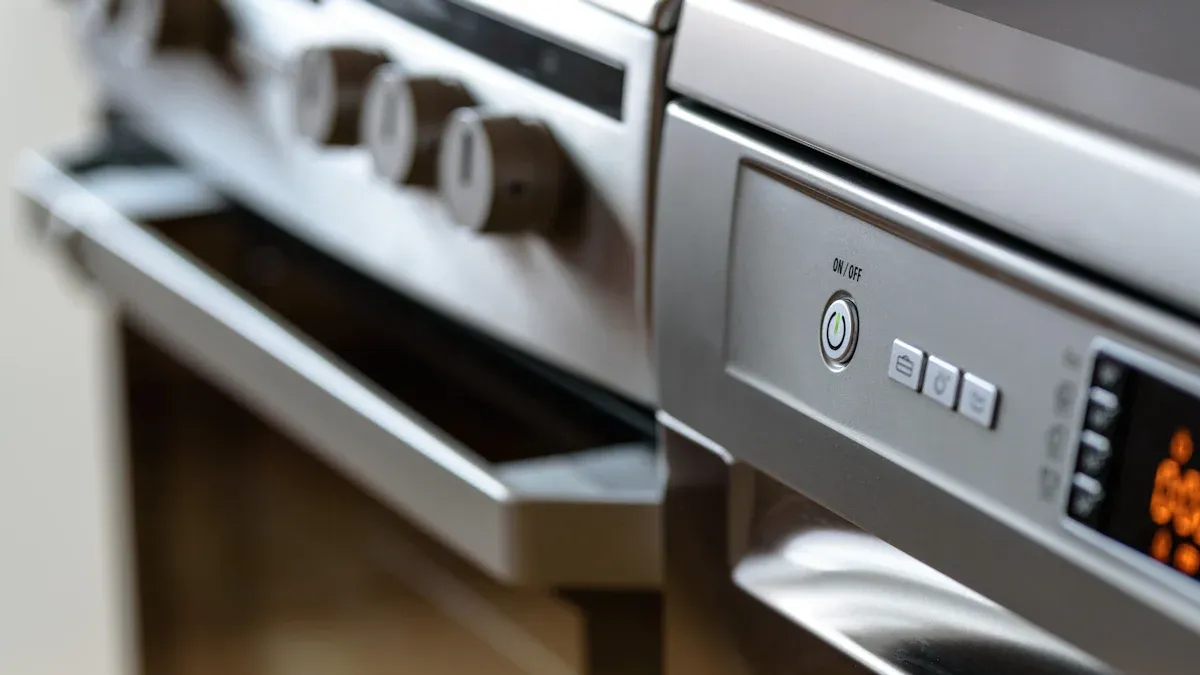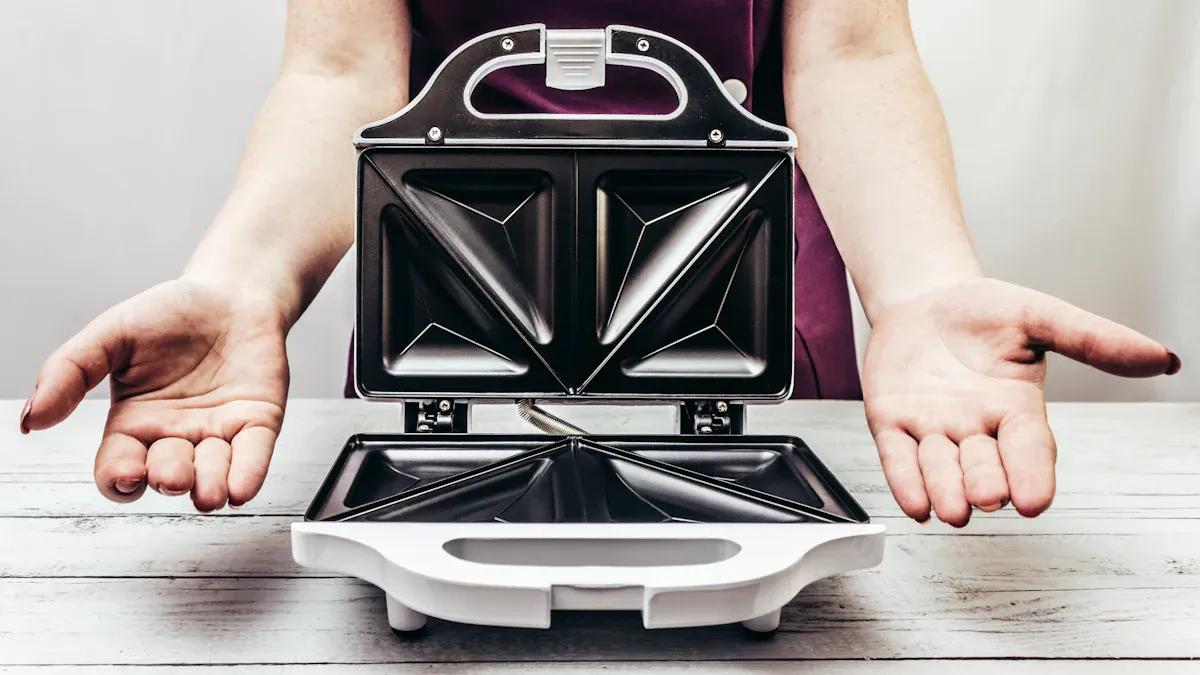
A clean sandwich press delivers consistent results and preserves food quality. Users should wipe away crumbs and residue after each use. Soft cloths and mild cleaners help prevent scratches and buildup. > Regular attention keeps the appliance working efficiently and reduces the risk of unwanted odors.
Principaux à retenir
- Nettoyez votre sandwich after every use by wiping plates and removing crumbs to keep it safe, fresh, and working well.
- Use gentle cleaning tools and mild detergents to protect non-stick surfaces and avoid damage to the appliance.
- Follow regular deep cleaning and proper storage routines to extend the life of your sandwich press and maintain even cooking.
Why Cleaning Your Sandwich Press Matters
Preventing Stuck-On Food and Odors
A clean sandwich helps maintain a safe and pleasant cooking environment. Food particles and sticky residue can accumulate quickly if users neglect regular cleaning.
- Wiping all surfaces with soap and water after each use removes debris and prevents buildup.
- Non-abrasive cleaning products and sponges protect the cooking surfaces from scratches.
- Regular sanitizing with disinfecting wipes or sprays eliminates bacteria and odors.
- Following manufacturer instructions and using appropriate cleaning tools preserves appliance performance.
- Proper cleaning ensures sandwiches taste fresh and the appliance remains safe and hygienic.
Cleaning immediately after use prevents food residue from hardening. This simple habit maintains hygiene and keeps the appliance ready for the next meal.
Ensuring Even Cooking and Performance
Consistent cleaning supports even cooking results. Non-stick or ceramic plates allow quick and effortless cleaning, which prevents food residue from building up. Removable plates enable thorough washing, ensuring surfaces remain hygienic and ready for use. Drip trays catch excess oil and crumbs, making cleaning easier and maintaining the appliance’s cleanliness. Fixed, non-removable plates improve heat distribution, ensuring every sandwich cooks evenly.
Extending the Life of Your Sandwich Press
Routine maintenance extends the lifespan of a sandwich press. Regular cleaning reduces microbial contamination risks and preserves appliance performance. Manufacturer guidelines emphasize cleaning to avoid buildup that causes stains, odors, and uneven heating. Neglecting cleaning leads to stuck-on food, residual odors, and potential bacterial growth, which can compromise both food safety and appliance functionality.
Daily Cleaning Steps for Your Sandwich Press

Unplug and Let the Sandwich Press Cool
Safety comes first when cleaning any kitchen appliance. Users should always unplug the sandwich after use. Allowing the appliance to cool completely prevents accidental burns and protects sensitive components from thermal shock. Most manufacturers recommend waiting at least 15 minutes before starting the cleaning process. This simple step ensures a safe and effective cleaning routine.
Conseil: Place a heat-resistant mat under the appliance while it cools to protect countertops from residual heat.
Wipe Plates with a Damp Cloth or Sponge
Once the sandwich press cools, users should remove any detachable grill plates or parts. Soaking these plates in warm, soapy water for 10 to 15 minutes dissolves grease and food residues. A soft brush works well to gently scrub away remaining debris. After rinsing the plates with clean water, users should dry them completely with a towel or allow them to air dry.
For fixed plates, a soft brush or damp cloth removes crumbs and food particles. Stubborn stains or grease buildup respond well to mild detergent mixed with water. Wiping the grill plates again with a soaked cloth ensures no soap or debris remains.
Daily Cleaning Steps at a Glance:
- Unplug and cool the appliance.
- Remove detachable parts if possible.
- Soak plates in warm, soapy water.
- Gently scrub with a soft brush.
- Rinse and dry thoroughly.
- For fixed plates, use a damp cloth or soft brush.
- Wipe again to remove any residue.
Clean the Exterior of the Sandwich Press
The exterior of the sandwich press often collects fingerprints, oil splatters, and crumbs. A damp cloth or sponge removes most surface dirt. For tougher spots, a small amount of mild detergent mixed with water helps break down grease. Users should avoid abrasive pads or harsh chemicals, as these can scratch or discolor the finish. Paying attention to handles, knobs, and hinges ensures the entire appliance stays clean and presentable.
Note: Never immerse the main body of the appliance in water. Moisture can damage electrical components.
Dry and Store Properly
Proper drying prevents rust and maintains hygiene. Users should dry all parts with a clean towel and, if possible, allow them to air dry fully before reassembly. Reassembling the sandwich press according to manufacturer instructions ensures all parts fit securely. Storing the appliance in a cool, dry place away from moisture and dust preserves its performance and extends its lifespan.
A light coating of cooking oil on clean, dry plates helps maintain non-stick surfaces and prevents food from sticking during the next use. Regular daily cleaning removes grease, food residues, and chlorides that can cause rust or damage, keeping the sandwich press spotless and ready for every meal.
Deep Cleaning Your Sandwich Press

When to Deep Clean
Deep cleaning becomes necessary when daily wiping no longer removes all residue. Users should schedule a deep clean every few weeks or after preparing foods with strong flavors or heavy oils. Signs such as persistent stains, lingering odors, or visible grease indicate the need for a thorough cleaning. Regular deep cleaning maintains optimal performance and food safety.
Removing Burnt-On Food and Stains
Burnt-on food and stubborn stains require special attention. Users can apply a paste of baking soda and water directly to the affected areas. After letting the paste sit for ten minutes, a soft brush or non-abrasive sponge helps lift the residue. For best results, repeat the process for tough spots. Avoid using metal tools, as these can damage the plates.
Conseil: For persistent stains, place a damp paper towel on the warm (not hot) plates for several minutes. The steam loosens debris for easier removal.
Cleaning Non-Removable Plates Safely
Non-removable plates present unique challenges. Users should never immerse the sandwich press in water. Instead, a damp cloth or sponge with mild detergent cleans the plates effectively. Take care to prevent water from entering electrical components. After cleaning, wipe the plates with a clean, damp cloth to remove any soap residue.
Handling Grease and Oil Buildup
Grease and oil can accumulate in corners and drip trays. Remove and wash drip trays in warm, soapy water. For hard-to-reach areas, use a soft brush or cotton swab. Regular attention to grease buildup prevents unpleasant odors and maintains the sandwich in top condition.
Do’s and Don’ts for Sandwich Press Care
Safe Cleaning Products and Tools
Selecting the right cleaning products and tools ensures the sandwich press remains in top condition. Many experts recommend gentle, non-toxic agents such as diluted vinegar for light cleaning and baking soda for stubborn grease. Eco-friendly dish soap with warm water removes residue effectively. Users should always rinse thoroughly to prevent soap buildup. Soft sponges or cloths protect non-stick surfaces from scratches. Occasionally, seasoning ceramic-coated plates with vegetable oil helps maintain their natural non-stick properties. Mintel’s research shows that consumers increasingly prefer safe, sustainable, and non-toxic cleaning products, reflecting a shift toward health-conscious and environmentally responsible cleaning routines.
What to Avoid to Prevent Damage
Certain practices can harm the sandwich press and shorten its lifespan. Avoid abrasive scrubbers, steel wool, or harsh chemicals, as these can scratch or erode non-stick coatings. Never immerse the appliance in water, which can damage electrical components. High heat settings may degrade non-stick surfaces over time. Users should also avoid using metal utensils on the plates. Instead, choose materials like ceramic or stainless steel for easier maintenance and durability.
Conseil: Always check for certifications such as FDA or LFGB when selecting a new panini press to ensure safety and ease of cleaning.
Common Mistakes with Sandwich Press Cleaning
Many users make simple mistakes that can lead to bigger problems. Forgetting to unplug the appliance before cleaning poses a safety risk. Skipping daily cleaning allows food residue and grease to build up, causing odors and uneven cooking. Using too much water or letting moisture seep into the electrical parts can result in permanent damage. Rushing the drying process may leave surfaces damp, increasing the risk of rust or mold. Following a consistent cleaning routine keeps the sandwich press spotless and running smoothly.
Long-Term Maintenance Tips for Your Sandwich Press
Proper Storage Practices
Proper storage protects the appliance from dust, moisture, and accidental damage. Users should always clean and dry the appliance before storing it. Placing the appliance in a cool, dry cabinet prevents rust and mold. Many owners wrap the power cord neatly to avoid tangling or fraying. Some prefer to store the appliance upright to save space and reduce pressure on the plates. A dedicated shelf or storage bin keeps the appliance separate from heavy cookware, which helps prevent scratches or dents.
Conseil: Use a soft cloth cover or a reusable bag to shield the appliance from dust when not in use.
Checking for Wear and Tear
Regular inspections help users spot early signs of damage. They should examine the power cord for cracks or exposed wires. Checking the plates for chips, scratches, or peeling coatings ensures safe operation. Hinges and handles should move smoothly without resistance. If any part feels loose or unstable, users should tighten screws or contact customer support for advice. Early detection of wear prevents accidents and extends the appliance’s lifespan.
Following Manufacturer Guidelines
Manufacturers provide specific instructions for cleaning, maintenance, and storage. Users should read the manual thoroughly and follow all recommendations. Many brands offer advice on safe cleaning agents and approved tools. Some models require periodic lubrication of hinges or inspection of electrical components. Adhering to these guidelines maintains warranty coverage and ensures optimal performance.
| Tâche de maintenance | Fréquence | Avantage |
|---|---|---|
| Clean and dry after use | Every use | Prevents buildup |
| Inspect for damage | Mensuel | Ensures safety |
| Follow manual | As instructed | Maintains performance |
Nettoyage et entretien réguliers keep appliances spotless and efficient. The right tools prevent scratches or damage. A user who wipes surfaces after each use ensures better performance and hygiene. Small efforts each day extend the life of any kitchen equipment, including a sandwich press.
FAQ
How often should users deep clean a sandwich press?
Most experts recommend deep cleaning every two to four weeks. Heavy use or frequent cooking of oily foods may require more frequent deep cleaning.
Can users use metal utensils on non-stick plates?
Metal utensils can scratch non-stick surfaces. Users should choose silicone, wood, or plastic tools to protect the coating and extend the life of the appliance.
What should users do if the sandwich press develops a persistent odor?
Place a mixture of baking soda and water on the plates. Let it sit for ten minutes. Wipe clean. This method helps neutralize lingering smells.

